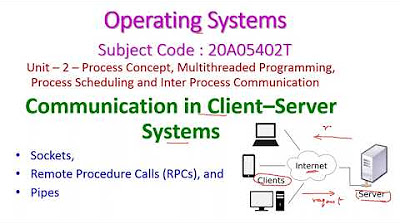What is the Client Server Model? | System Design Concepts
Summary
TLDRThis video script delves into the client-server model, a fundamental concept for developers. It explains the roles of clients, which request information, and servers, which provide it, often through APIs using HTTP. The script also contrasts this centralized model with the decentralized peer-to-peer model, exemplified by torrent networks. The video aims to educate viewers on how information is exchanged over the internet.
Takeaways
- 🌐 **Client-Server Model Definition**: The client-server model is a fundamental concept for understanding how machines communicate and exchange information over the internet.
- 💻 **Client Roles**: Clients can be web browsers, mobile devices, or programs that request information from servers, similar to customers ordering in a restaurant.
- 🔌 **Server Functions**: Servers act as providers of information, which can be stored locally or accessed from other systems, such as databases.
- 📡 **Communication Protocol**: Clients and servers communicate using network protocols, with HTTP being the most common.
- 📱 **Client Diversity**: Clients are diverse, including browsers, devices, and programs, all of which interact with servers to request data.
- 📚 **Server-Database Connection**: Servers are often connected to databases, retrieving data from them in response to client requests.
- 🔗 **APIs as Contracts**: Application Programming Interfaces (APIs) serve as contracts between clients and servers, defining how information is requested and provided.
- 🔁 **Request-Response Cycle**: The client-server interaction involves clients making requests and servers responding with the requested data or performing operations.
- 🌐 **Centralized vs Decentralized**: The client-server model is centralized, with servers holding authoritative information and clients being decentralized requesters.
- 🔄 **Peer-to-Peer Alternative**: The peer-to-peer (P2P) model contrasts with the client-server model by having each participant act as both a consumer and producer of information, without a central server.
Q & A
What is the client-server model?
-The client-server model is a concept in computing where a client, which can be a web browser, a mobile device, or a program, requests information from a server, which is the provider of information. This model is fundamental to how machines communicate and exchange data over the internet.
What are the common examples of clients in the client-server model?
-Common examples of clients include web browsers like Firefox, Chrome, or Safari, mobile devices such as iPhones or iPads, and programs written in languages like Python, Java, or C++ that run on a computer.
How does a client communicate with a server?
-A client communicates with a server using a network protocol language, with HTTP (Hypertext Transfer Protocol) being the most common one. The client makes a request to the server, which then responds with the requested information.
What is the role of a server in the client-server model?
-In the client-server model, the server acts as the provider of information. It may have access to information stored locally or it may know how to retrieve it from another source, such as a database. The server also exposes APIs (Application Programming Interfaces) that define the contract for how clients can request information or services.
What is an API in the context of the client-server model?
-An API (Application Programming Interface) in the client-server model is a set of rules and protocols for building and interacting with software applications. It defines how clients can request information or services from a server, and what data the server will return in response.
How does the client-server model facilitate the exchange of data over the internet?
-The client-server model facilitates data exchange by allowing clients to make HTTP requests to servers. The server then retrieves the requested data, possibly from a database or another server, and returns it to the client via APIs, fulfilling the contract established by the API.
What is the centralized approach in the client-server model?
-The centralized approach refers to the concept where servers act as the single source of authoritative information in the client-server model. Clients are decentralized and exist anywhere on the internet, but they rely on centralized servers to provide data and functionality.
What is the difference between the client-server model and the peer-to-peer model?
-In the client-server model, there is a clear distinction between clients that request information and servers that provide it. In contrast, the peer-to-peer model is decentralized, with each participant acting as both a consumer and a producer of information, sharing equally in the network.
How does the peer-to-peer model work?
-In a peer-to-peer model, each participant in the network can both request and provide data to other participants. There is no central server; instead, participants share resources and information directly with each other, as seen in networks like BitTorrent.
Why is the client-server model essential for developers?
-Developers need to understand the client-server model because it is fundamental to building applications that communicate over the internet. Whether they are building client components, server components, or something in between, this model is crucial for how applications interact and exchange data.
What are some alternatives to the client-server model mentioned in the video?
-The video mentions peer-to-peer (P2P) as an alternative to the client-server model. In a P2P model, there is no central server; instead, each participant acts as both a client and a server, sharing resources and information directly with others in the network.
Outlines

هذا القسم متوفر فقط للمشتركين. يرجى الترقية للوصول إلى هذه الميزة.
قم بالترقية الآنMindmap

هذا القسم متوفر فقط للمشتركين. يرجى الترقية للوصول إلى هذه الميزة.
قم بالترقية الآنKeywords

هذا القسم متوفر فقط للمشتركين. يرجى الترقية للوصول إلى هذه الميزة.
قم بالترقية الآنHighlights

هذا القسم متوفر فقط للمشتركين. يرجى الترقية للوصول إلى هذه الميزة.
قم بالترقية الآنTranscripts

هذا القسم متوفر فقط للمشتركين. يرجى الترقية للوصول إلى هذه الميزة.
قم بالترقية الآن5.0 / 5 (0 votes)






